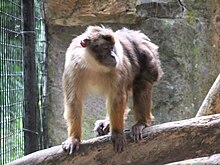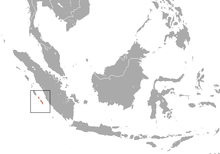Pagai Island macaque
| Pagai Island macaque[1] | |
|---|---|

| |
| Captive Pagai Island macaque, Cisarua, West Java, Indonesia | |
| Scientific classification | |
| Domain: | Eukaryota |
| Kingdom: | Animalia |
| Phylum: | Chordata |
| Class: | Mammalia |
| Order: | Primates |
| Suborder: | Haplorhini |
| Infraorder: | Simiiformes |
| Family: | Cercopithecidae |
| Genus: | Macaca |
| Species: | M. pagensis
|
| Binomial name | |
| Macaca pagensis (Miller, 1903)
| |

| |
| Pagai Island macaque range | |
The Pagai Island macaque (Macaca pagensis), also known as the Pagai macaque or Bokkoi, is an
Description
Pagai Island macaque males are generally larger than females. The males' body lengths range from 45–55 cm (18–22 in) and females' body lengths are around 40–45 cm (16–18 in). Tail length is 13–16 cm (5.1–6.3 in) for males and 10–13 cm (3.9–5.1 in) for females. Males are also heavier, weighing around 6–9 kg (13–20 lb) while females weigh 4.5–6 kg (9.9–13.2 lb). Their backs have a dark brown coloration, and chestnut to pale ochre on the sides of the neck, the front of the shoulders and the undersides of this species. Legs are brown and their arms, reddish brown. The faces of Mentawai macaques are furless and black-skinned with brown eyes. They have cheek pouches to carry food while foraging.
Habitat and ecology
The macaques' natural habitat is
Reproduction
Females show fertility and willingness to mate by displaying their swollen and reddened genitals. Females crouch to initiate mating. The gestation period is between five and six months. A single offspring is born during the night. The mother eats the placenta and licks the infant clean before morning. The mother and young share a close bond into adulthood.
Population and threats
The species' primary habitat is on the Mentawai Islands 150 km (93 mi) off the west coast of Sumatra. They populate three of the four major islands in the chain (

